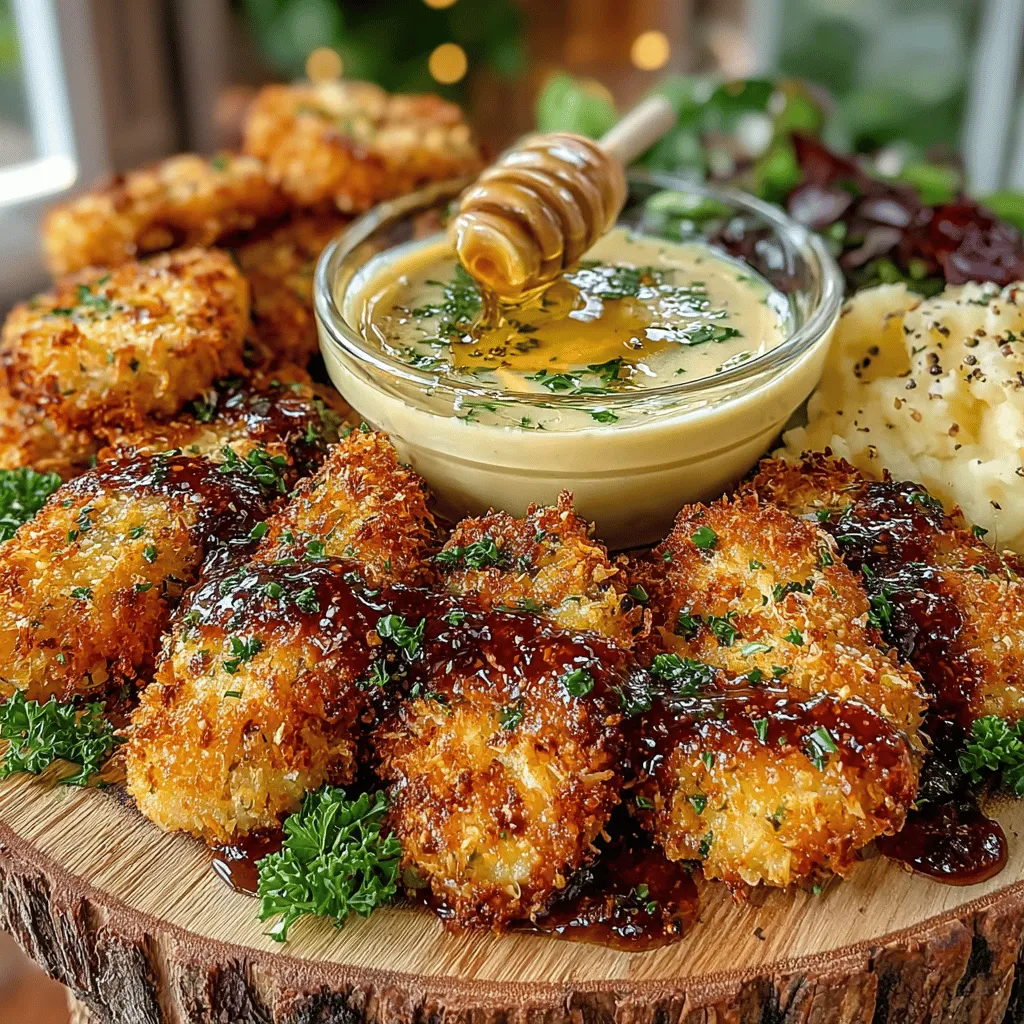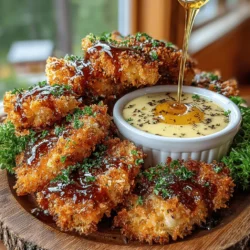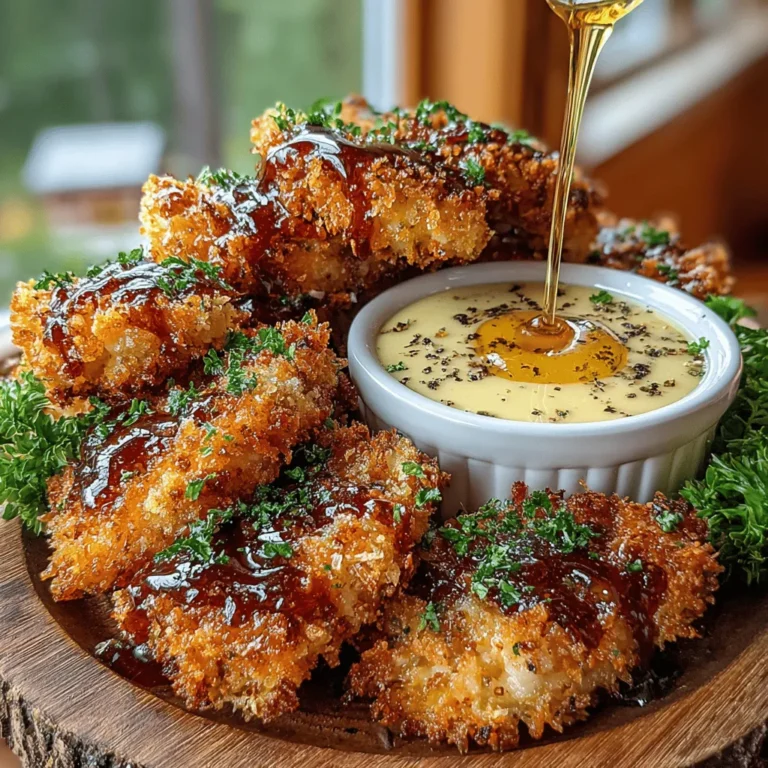Introduction to Crispy Chicken Tenders with Honey Mustard Dip
In the world of comfort food, few dishes can rival the delight of crispy chicken tenders. This classic dish is not only loved by children but also adored by adults for its crunchy texture and juicy flavor. The addition of a tangy honey mustard dip elevates this simple recipe to new heights, making it a perfect choice for family dinners, game day snacks, or even a fun gathering with friends. In this article, we will guide you through creating mouthwatering crispy chicken tenders paired with a delectable honey mustard dip, ensuring that you can recreate this restaurant-quality dish in the comfort of your own kitchen.
Ingredients
– 1 pound chicken tenderloins
– 1 cup buttermilk
– 1 teaspoon garlic powder
– 1 teaspoon onion powder
– 1 teaspoon smoked paprika
– Salt and pepper to taste
– 1 cup all-purpose flour
– 2 cups panko breadcrumbs
– 1 large egg
– Cooking oil for frying
For the Honey Mustard Dip
– 1/2 cup mayonnaise
– 1/4 cup honey
– 1/4 cup Dijon mustard
– Salt and pepper to taste
Instructions
1. Marinate the Chicken: In a large bowl, combine the buttermilk, garlic powder, onion powder, smoked paprika, salt, and pepper. Add the chicken tenderloins and ensure they are well coated in the marinade. Cover and refrigerate for at least 1 hour, preferably overnight.
2. Prepare the Breading Station: Set up three shallow dishes: one with flour, one with a beaten egg, and one with panko breadcrumbs. This will streamline the breading process.
3. Coat the Chicken: Remove the marinated chicken from the refrigerator. Dredge each piece first in flour, shaking off any excess. Dip it into the beaten egg, then coat it thoroughly with panko breadcrumbs. Press the breadcrumbs onto the chicken to ensure an even coating.
4. Heat the Oil: In a large skillet, heat about 1/2 inch of cooking oil over medium-high heat. You can test if the oil is ready by dropping a small piece of bread into it; if it sizzles and bubbles, the oil is hot enough.
5. Fry the Chicken Tenders: Carefully add the breaded chicken tenders to the hot oil in batches, avoiding overcrowding the pan. Fry each side for about 3-4 minutes or until golden brown and cooked through. Use a meat thermometer to ensure the internal temperature reaches 165°F.
6. Drain and Serve: Once cooked, transfer the chicken tenders to a plate lined with paper towels to drain any excess oil.
7. Make the Honey Mustard Dip: In a small bowl, whisk together the mayonnaise, honey, Dijon mustard, salt, and pepper until smooth. Adjust the seasoning to taste.
8. Serve: Plate the crispy chicken tenders alongside the honey mustard dip for a delicious meal or snack.
The Allure of Crispy Chicken Tenders
Understanding the Popularity of Chicken Tenders
Chicken tenders have become a staple in many households due to their appealing taste and ease of preparation. They can be enjoyed plain, spiced up, or served with various dipping sauces, making them versatile for any occasion.
Exploring the Versatility of Chicken Tenders in Cuisine
From casual family dinners to upscale restaurant menus, chicken tenders can be adapted to fit any culinary style. They can be served with salads, in sandwiches, or as part of a buffet spread.
The Cultural Significance of Chicken Tenders Across Various Regions
In the United States, chicken tenders have gained iconic status, especially in Southern cuisine, where they are often paired with biscuits and gravy. Their presence at sporting events and fast-food chains further solidifies their importance in American food culture.
Ingredient Spotlight: What Makes These Chicken Tenders Special
Breaking Down the Chicken Tender Ingredients
Each ingredient plays a vital role in creating the perfect crispy chicken tender. Understanding these components can help you enhance your cooking techniques.
The Role of Buttermilk in Marinating Chicken for Tenderness
Buttermilk not only adds flavor but also acts as a tenderizer, ensuring the chicken remains moist throughout the cooking process.
How Spices Like Garlic Powder, Onion Powder, and Smoked Paprika Enhance Flavor
Using a blend of spices adds depth and complexity to the chicken, making every bite flavorful.
The Importance of Panko Breadcrumbs for Achieving the Ultimate Crunch
Panko breadcrumbs offer a light, airy texture that results in a crispy exterior, setting these chicken tenders apart from the rest.
Discussing Optional Ingredients Like Cayenne Pepper for Heat
For those who enjoy a bit of spice, adding cayenne pepper to the breading mixture can elevate the flavor profile and provide an exciting kick.
Preparing the Chicken: The Marination Process
The Science Behind Marinating Chicken
Marinating chicken in buttermilk allows the acid and enzymes to break down the proteins, resulting in a more tender and flavorful product.
Step-by-Step Guide to Marinating Chicken in Buttermilk
1. Combine buttermilk with spices in a large bowl.
2. Add chicken tenders and ensure they are fully submerged.
3. Cover and refrigerate for a minimum of 1 hour or overnight for best results.
Tips for Marinating Time – Why Overnight is Optimal
Longer marination times allow the flavors to penetrate more deeply, enhancing the overall taste and texture of the chicken.
What to Expect During the Marination Process
After marinating, the chicken will appear slightly plumper, indicating that it has absorbed moisture and flavor.
Setting Up Your Breading Station
Creating an Efficient Breading Workflow
An organized workspace is essential for a smooth cooking process. Set up your breading station in a sequential manner to minimize mess and maximize efficiency.
Choosing the Right Dishes for Breading: Flour, Buttermilk, and Panko
Using shallow dishes will make it easier to coat the chicken evenly without creating a mess.
Importance of a Clean Workspace and Proper Tools for Ease
Maintaining a tidy area helps prevent cross-contamination and makes the cooking process more enjoyable.
The Breading Technique: Achieving Perfectly Coated Chicken
Detailed Instructions for Breading Chicken Tenders
Follow these steps for a flawless breading technique:
1. Dredge in flour, ensuring an even coating.
2. Dip in beaten egg, allowing excess to drip off.
3. Coat thoroughly in panko breadcrumbs, pressing gently to adhere.
Step-by-Step on How to Coat Chicken Strips Properly
This method ensures that each chicken tender is covered completely, promoting even cooking and a deliciously crispy texture.

Tips for Perfecting Your Chicken Tenders
Understanding the Significance of Each Layer in the Breading Process
The breading of chicken tenders is crucial for achieving that desired crunch. Each layer plays a specific role: the flour helps the egg adhere, while the egg binds the breadcrumbs, creating a thick and crispy exterior. Ensure even coverage on each piece for optimal texture.
Common Mistakes to Avoid While Breading
Avoid rushing the breading process. Ensure each tender is well-coated before moving to the next step. A common mistake is not letting the breaded tenders rest before frying; this ensures the breading adheres better during cooking. Additionally, don’t overcrowd the frying pan, as this can lower the oil temperature and result in soggy tenders.
Frying Chicken Tenders to Perfection
Choosing the Right Oil for Frying
Opt for oils with high smoke points, such as canola, peanut, or vegetable oil. These oils withstand high temperatures without breaking down, which is essential for achieving a crispy finish.
How to Know When the Oil is Ready for Frying
To test the oil, drop a small piece of bread into the hot oil. If it bubbles and browns in about 60 seconds, the oil is ready. Alternatively, you can use a thermometer; the ideal frying temperature is around 350°F to 375°F.
Techniques for Frying Chicken Tenders Evenly
Fry in batches to maintain oil temperature and ensure even cooking. Turn the tenders only once or twice to allow a golden crust to form. Use a slotted spoon to lift them out of the oil, letting excess oil drain before placing them on a paper towel-lined plate.
Signs of Perfectly Cooked Chicken Tenders: Color and Texture
Look for a deep golden-brown color and a crispy exterior. The internal temperature of the chicken should reach 165°F. When cutting into the tenders, they should be juicy, with no pinkness inside.
Crafting the Honey Mustard Dip
Ingredients Breakdown for a Balanced Dip
For the perfect honey mustard dip, combine equal parts mayonnaise and Dijon mustard, then add honey to taste. This balance creates a creamy, tangy, and sweet flavor that complements the chicken perfectly.
The Importance of Mayonnaise, Dijon Mustard, and Honey in Achieving the Right Taste
Mayonnaise provides creaminess, while Dijon mustard brings a sharp tang. Honey adds sweetness, harmonizing the flavors. Adjust the quantities to suit your taste preferences; for a spicier dip, consider adding a pinch of cayenne pepper or a splash of hot sauce.
Tips for Storage and Serving Suggestions for the Dip
Store any leftover dip in an airtight container in the refrigerator for up to a week. Serve it chilled for the best flavor. For an appealing presentation, consider serving the dip in a small bowl surrounded by fresh herbs or sliced vegetables.
Serving Suggestions: Pairing and Presentation
Best Practices for Arranging Your Dish
Arrange the crispy chicken tenders on a platter, alternating their direction for visual appeal. Place the honey mustard dip in the center for easy access. Consider garnishing with fresh parsley or lemon wedges for a pop of color.
Creative Serving Ideas for Chicken Tenders and Honey Mustard Dip
For a fun twist, serve the chicken tenders on skewers or in mini sliders. Pair them with a variety of dips, such as barbecue or ranch, to accommodate different tastes at gatherings.
Complementary Sides That Enhance the Meal Experience
Serve your chicken tenders with a side of coleslaw, sweet potato fries, or a fresh garden salad. These sides not only complement the meal but also add nutritional balance.
The Health Aspect of Chicken Tenders
Nutritional Information for a Balanced Meal
Chicken tenders can fit into a balanced diet when enjoyed in moderation. A typical serving contains protein, but consider the calorie count from frying.
Modifying the Recipe for Healthier Alternatives (Baking vs. Frying)
For a healthier option, bake the chicken tenders instead of frying. Preheat the oven to 400°F. Place the breaded tenders on a baking sheet and spray with cooking oil; bake for 20-25 minutes, flipping halfway through, until crispy and cooked through.
Understanding Portion Control and Serving Sizes
Be mindful of portion sizes. A serving of chicken tenders is typically around three to four pieces. Pair it with plenty of vegetables or a salad to create a more filling and nutritious meal.
Conclusion: Enjoying Your Crispy Chicken Tenders with Honey Mustard Dip
Creating crispy chicken tenders at home is a rewarding experience that brings joy to both the cook and those enjoying the meal. The satisfaction of savoring homemade dishes enhances the entire dining experience. Don’t hesitate to experiment with different flavors and ingredients to make this dish uniquely yours. Whether you choose to fry or bake, the key is to enjoy the process and share delicious meals with loved ones.


